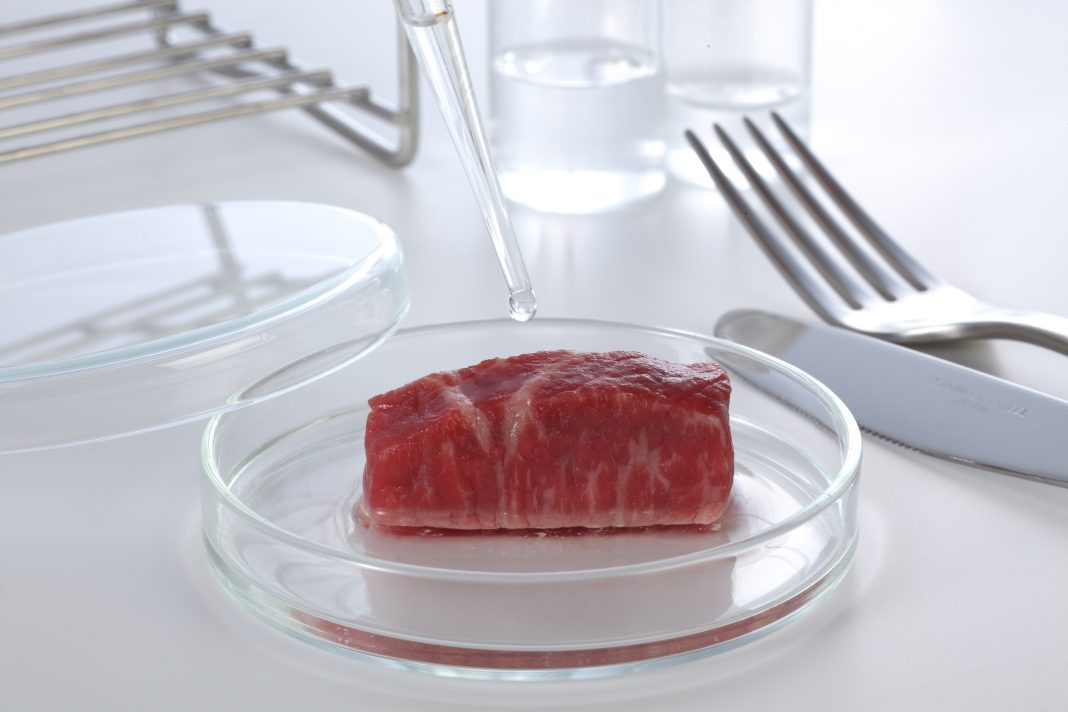Researchers growing fat tissue from cells to make cultured meat have successfully developed a similar texture to natural meat grown in animals
The increasing production of cultured meat grown entirely from cells is highly anticipated to break into the food industry – especially due to the increasing environmental and ethical issues with natural meat – but these meats currently lack realistic texture and flavour.
Though not yet ready for large-scale production, startup companies are developing cell-grown chicken, beef, pork, and fish. Currently, most of these products are in the form of an unstructured mixture of cells, such as chicken nuggets rather than a slice of chicken breast.
What is lacking is the texture of real meat, created by muscle fibres, connective tissue and fat. Essentially, what gives meat its flavour.
The texture of real meat is currently ‘lacking’ from the cultured meat
To tackle this, researchers adapted the texture of cultured meat by compressing the fat tissue, seeing how much pressure it could withstand compared to natural animal fat.
This showed that cell-grown fat bound with sodium alginate was able to withstand a similar amount of pressure to fat from livestock and poultry, but the cell-grown fat that was bound with mTG behaved more like rendered fat, similar to lard or tallow, suggesting it would be possible to adapt the texture of cultured fat to make it resemble the texture of real fat within meat.
The mix of fatty acids from cultured mouse fat differed from native mouse fat
Using different types and amounts of binders, the researchers analysed the composition of molecules from the cell-grown fat and found that the mix of fatty acids from cultured mouse fat differed from native mouse fat. However, the cultured pig fat had a much closer fatty acid profile to the native tissue, suggesting the different cultured meats would have different results.
While it might be possible to supplement growing fat cells with the required lipids to ensure that they more closely match the composition of natural meat, cooking releases hundreds of compounds that add flavour to the meat, and most of those compounds originate from fat, including lipids and their component fatty acids.
How much fat does cultured meat need to have enough flavour?
Consumer testing with natural beef of different fat content showed that the highest scores were registered for beef containing 36% fat.
This issue with this is the production of cultured fat tissue in large enough quantities is extremely difficult so far. This is because, as the fat grows into a mass, the cells in the middle become starved of oxygen and nutrients. In nature, blood vessels and capillaries deliver oxygen and nutrients throughout the tissue.
Currently, there still isn’t a way to replicate that vascular network at a sufficient scale in lab-grown tissue.
Lab-grown muscle and fat can only be grown to a few millimetres in size
In this study, researchers noted that they can only grow muscle or fat to a few millimetres in size.
To tackle this, the researchers grew fat cells from mice and pigs first and then harvested those cells and aggregated them into a three-dimensional mass with a binder such as alginate and mTG, which are both already used in some foods. The aggregated fat cells immediately had the appearance of fat tissue, but to see if they truly reproduced the features of native fat from animals, the team carried out a series of further experiments.
Aggregating the cells after growth could reproduce the taste, nutrition and texture profile of natural animal fat
First author John Yuen Jr, a graduate student at the Tufts University Center for Cellular Architecture, said: “Our goal was to develop a relatively simple method of producing bulk fat. Since fat tissue is predominantly cells with few other structural components, we thought that aggregating the cells after growth would be sufficient to reproduce the taste, nutrition and texture profile of natural animal fat.
“This can work when creating the tissue solely for food, since there’s no requirement to keep the cells alive once we gather the fat in bulk.”
Senior author David Kaplan, Stern Family professor of Biomedical Engineering at Tufts University and director of TUCCA, added: “This method of aggregating cultured fat cells with binding agents can be translated to large-scale production of cultured fat tissue in bioreactors – a key obstacle in the development of cultured meat.
“We continue to look at every aspect of cultured meat production with an eye toward enabling mass production of meat that looks, tastes and feels like the real thing.”











